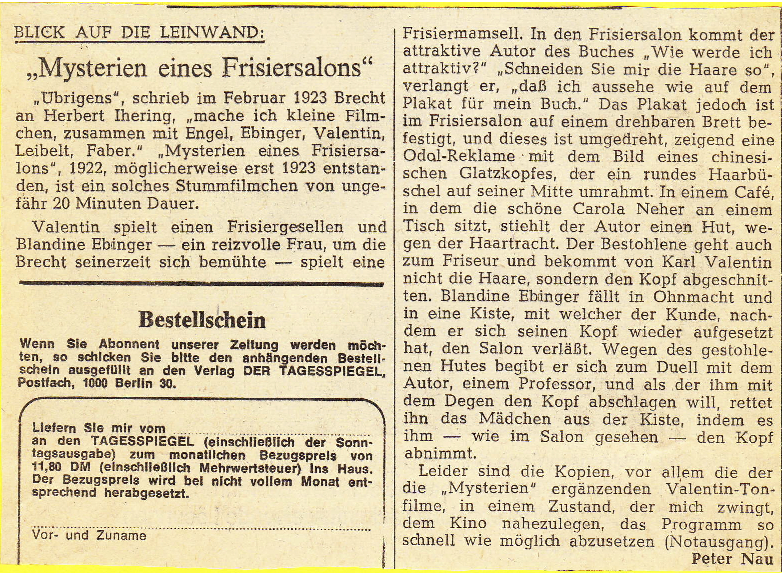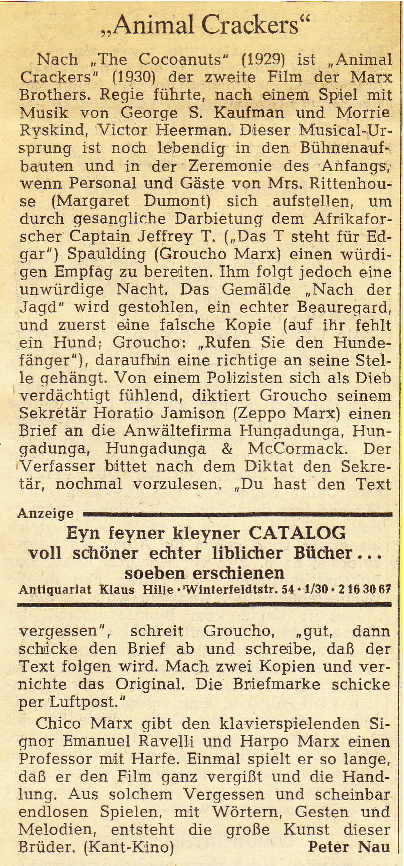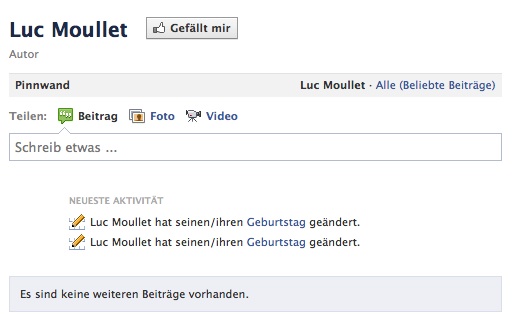Februar 2012
Dienstag, 28.02.2012
Montag, 27.02.2012
Unsere Jungs und Mädels von der Bundesregierung – reichlich breit
„Damit Filmklassiker auch in Zukunft noch von einem breiten Publikum gesehen werden können, müssen sie digitalisiert werden. Der Bund fördert daher die Digitalisierung des nationalen Filmerbes.
Ob Murnaus Stummfilm „Nosferatu“ oder Carl von Sternheims „Der blaue Engel“ mit Marlene Dietrich – ohne die Digitalisierung könnten Filmklassiker wie diese bald nicht mehr in deutschen Kinos gezeigt werden. Im Zuge der Umrüstung der Kinos auf digitale Projektion werden die analogen 35-Millimeter-Filmrollen bald der Vergangenheit angehören.“
Kann der wirkliche Carl von Sternheim bitte aufstehen?
Die volle Breitseite ist hier.
Samstag, 25.02.2012
Véronique Goël im Regenbogenkino (Berlin)
Vom 1. bis 19. März zeigt das Regenbogenkino eine Reihe mit Filmen von Véronique Goël. Anne Grèzes hat sie zusammengestellt und auch Filme von anderen hinein gruppiert (Bärbel Freund, Karl Heil, Rainer Bellenbaum, Boris Lehman, Stephen Dwoskin, Jean-Marie Straub, Bernhard Sallmann, Wolfgang Höpfner, Thomas Keller, Kenneth Macpherson, Danniel Danniel).
Auf der »Langtextseite« gibt’s ein Faksimile des Faltblatts zur Reihe.
Freitag, 24.02.2012
Donnerstag, 23.02.2012
Kinohinweis (München)
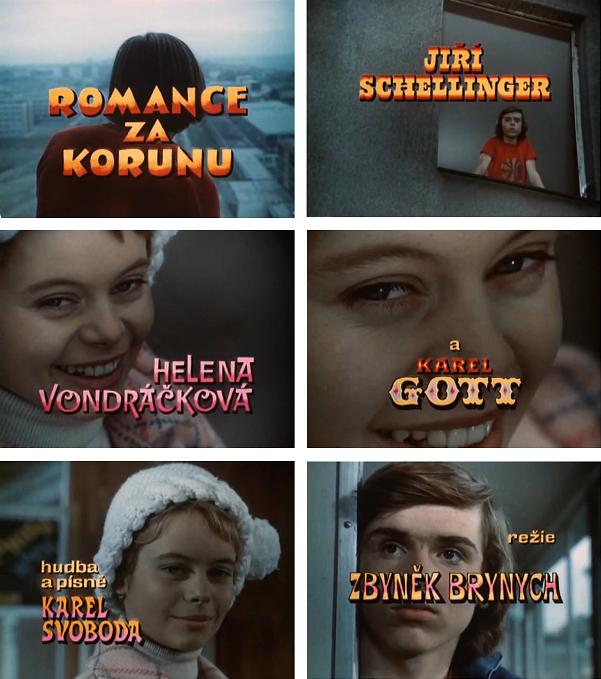 Einen Film von ihm erkennt man, bevor sein Name im Vorspann erscheint.
Einen Film von ihm erkennt man, bevor sein Name im Vorspann erscheint.
Seit Zbyněk Brynych vor nun schon fast zwei Jahrzehnten von Stefan Ertl „entdeckt“ wurde, hat Dominik Graf unermüdlich und, wie man inzwischen hier und da und dort lesen kann, mit einigem Erfolg auf diese Entdeckung hingewiesen. Brynychs unglaubliche Filme im Kino sehen zu können, ist dennoch ein sehr seltenes Vergnügen.
Werner Kließ schrieb in FILM über Brynychs Oberhausenbeitrag von 1964, den 40 minütigen Misto: „Jungen von etwa sechzehn Jahren haben die Brutalität und die Unschuld von Bestien. Ihre Grausamkeit ist ursprünglich, direkt, unverhüllt. Der Film ist genau, insofern er den Vorgang der Rollenwahl in einer Gruppe präzis zum Ausdruck bringt. Der Film ist unauffällig in seinen Kunstmitteln. Der Film ist schön. Das unverbrauchte Spiel der Jugendlichen offenbart Unschuld. Nicht die Unschuld der Frommen, sondern die des unreflektierten Daseins.“
Morgen und am Samstag zeigt das Werkstattkino Der Kommissar – Papierblumenmörder (1970) und dazu als Vorfilm: Misto / Der Platz (1964); am Sonntag dann Die Nacht von Lissabon (1971), 35mm; am Montag, Dienstag und Mittwoch Oh Happy Day (1970), 35mm; jeweils um 22:30.
Dienstag, 21.02.2012
Kinohinweis (Berlin)
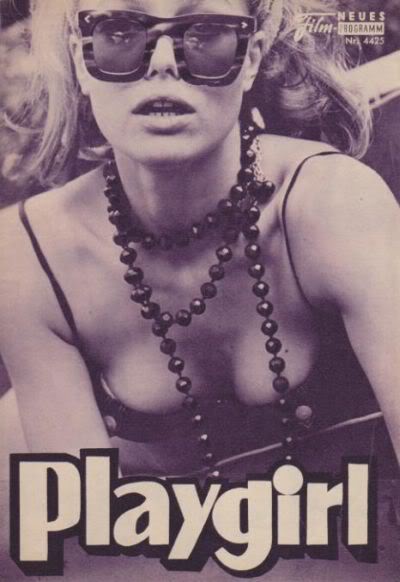
Im Bundesplatz-Kino wird am Sonntag, 26.2. in der Matinee-Vorstellung um 11.00 Uhr Will Trempers selten gezeigter »Playgirl« gespielt. Hier ist ein Langtext über den Film.
(Jeans von Nicolette Krebitz würde ich auch gern mal wieder gucken.)
Sprocket Holes
Very good news: Anlässlich einer Morgan Fisher-Ausstellung in der Sammlung Generali ist für den Mai eine Ausgabe seiner Texte angekündigt.
Unter den Texten, die ich von ihm kenne (über seine eigenen Filme, über Carl André), sind nur hits, no misses. Weiterhin sehenswert: Wie er über »expressivity, richness of life, abundance, film as a medium, sound, sync, time, picture, film and cinema history« spricht.
Zuletzt gefiel mir sein Vorschlag, die Medienspezifik des Films aus den Perforationslöchern herzuleiten:
»Film’s material base is inseperable from our understanding of it. That’s why sprocket holes, even more than frames, are the universal emblem of film. Before there can be frames there must be sprocket holes. We know that every film has them. And although we can’t see the sprocket holes when we watch a film, the medium is present in what we see on the screen.« (in: Tacita Dean: Film, ed. by Nicholas Cullinan, London: Tate 2011, p. 70)
Sonntag, 19.02.2012
Samstag, 18.02.2012
Andrei Ujica at Harvard (notes)
Last October the Harvard Film Archive presented Ujica’s trilogy about the collapse of the communist states. Now the Romanian director visited and took questions after a repeated screening of THE AUTOBIOGRAPHY OF NICOLAE CEAUSESCU.
He first stated that this is a syntactic and not a compilation film. His intention was to deconstruct the propaganda footage, converting it back to quasi rushes and start his own editing, thus using a different approach than compiling pre-existing fragments.
The idea for the film title came up when his friend Peter Sloterdijk gave him Norberto Fuentes’ ‘Autobiography of Fidel Castro’.
Asked about the soundtrack he felt extremely lucky to have had the editor and sound designer in one person: Dana Bunescu. Their footage was 90% silent, so they had to partly create natural ambiences, but furthermore created several layers of abstraction, between the extremes of total silence and two pieces of the composer Ligeti (in the scene with the gigantic futuristic city model). The use of total silence for some interior scenes was meant to obtain a degree of purity; all sound was chosen for dramaturgical reasons “to break the rhythm of the propaganda river”. And then again they let audio sequences stand by themselves to a black screen (the screaming at the earthquake 1977).
Which audience did he intend his film for? Ujica had his students, the younger generation, in mind. And to the question whether he tested audience reactions before final cut and release of the film, he vehemently responded that he would never do that! (This I find extraordinary and remarkable, since all these rough cut screenings, previews etc. are common practice, and you certainly could argue a lack of artistic confidence or calculation in contemporary filmmaking and discuss the reasons for it.) He then talked quite a bit about the trauma which followed the shooting of Ceausescu and his wife – “a legal crime”, comprehensible because the dictator had created so much hate. While feeling much the same way Ujica found a new approach to Ceausescu during his work on the film. After an audience comment on the obvious humourous accents in the film (like during a parade you can see a movie theatre in the background, advertising DEEP THROAT) he described that he became more interested in the “Shakespearean tragical element” of the dictator who stayed – visible through all the pomp – the plain peasant, who he was from birth. This discrepancy fascinated Ujica and became prevalent in his film. Ceausescu was a fundamental communist, not so much a pathological/corrupt dictator like Stalin or Hitler. He really believed in the ideology of his time.
Ujica sees his film as a “fresco of modern communist rule”, capturing “the appealing structure of a completely wrong ideology”, clearly the Potemkin village… This irony is central in the film, and it cuts more than one way. Carter does not fare so well either. “The masquerade is more general”.

